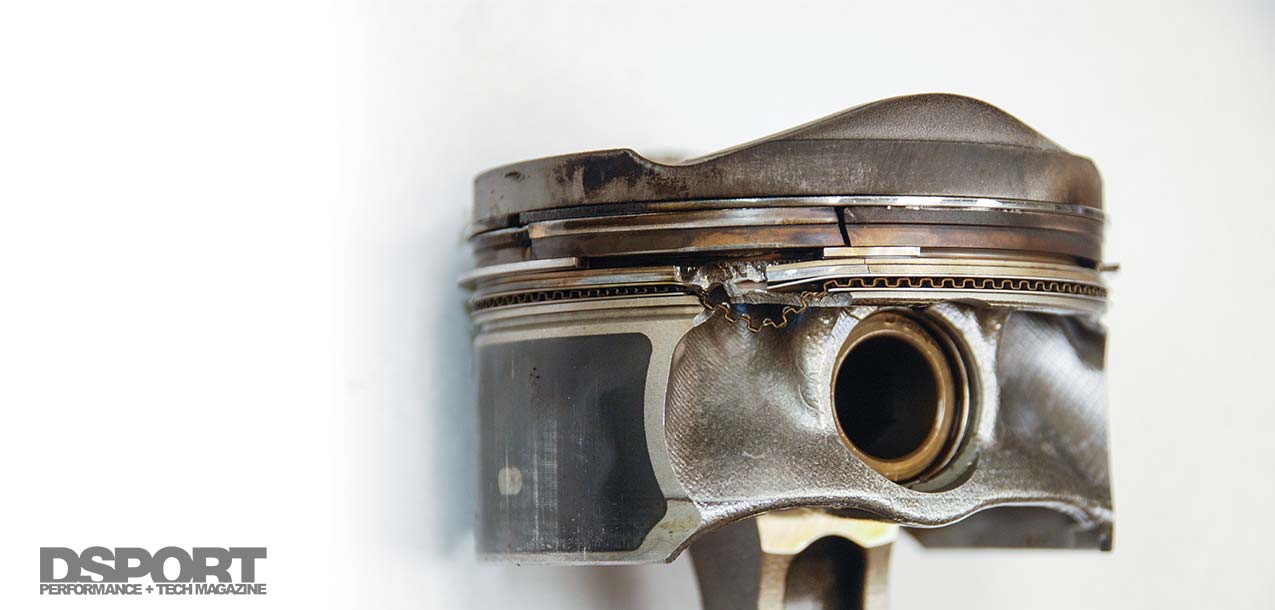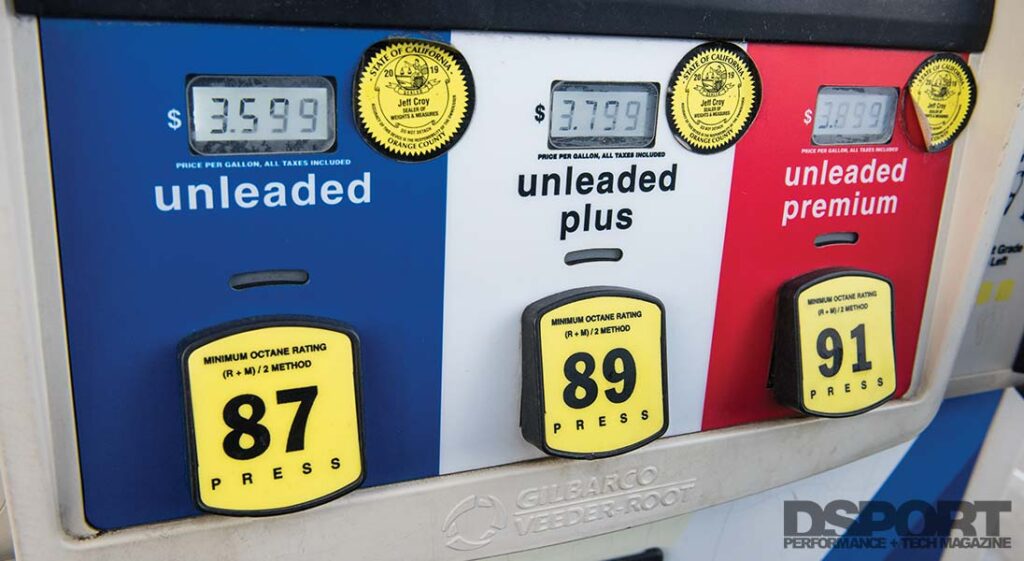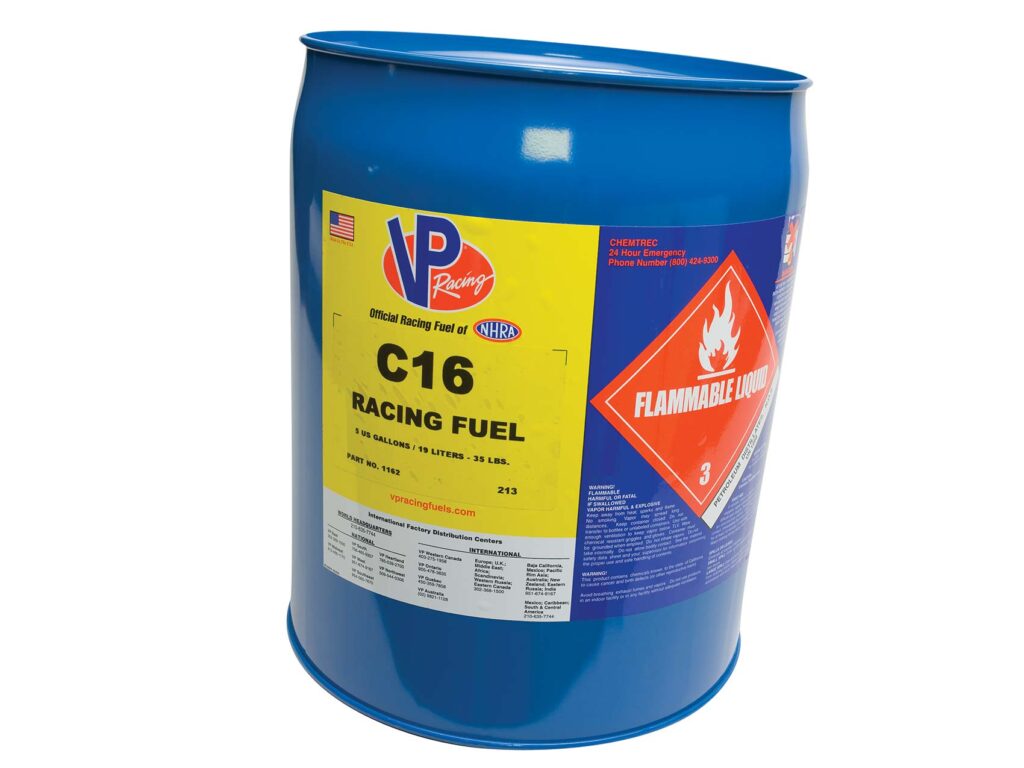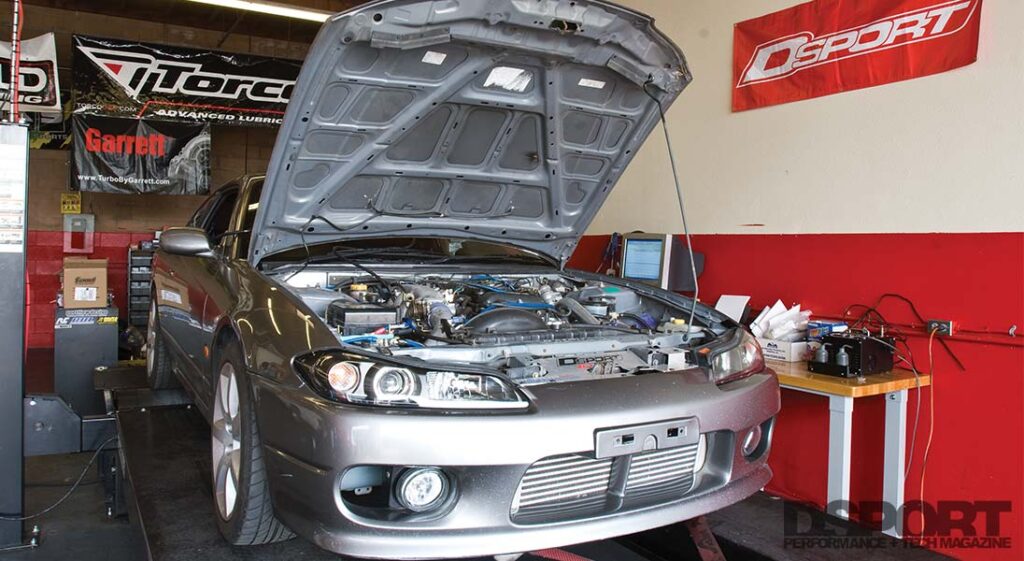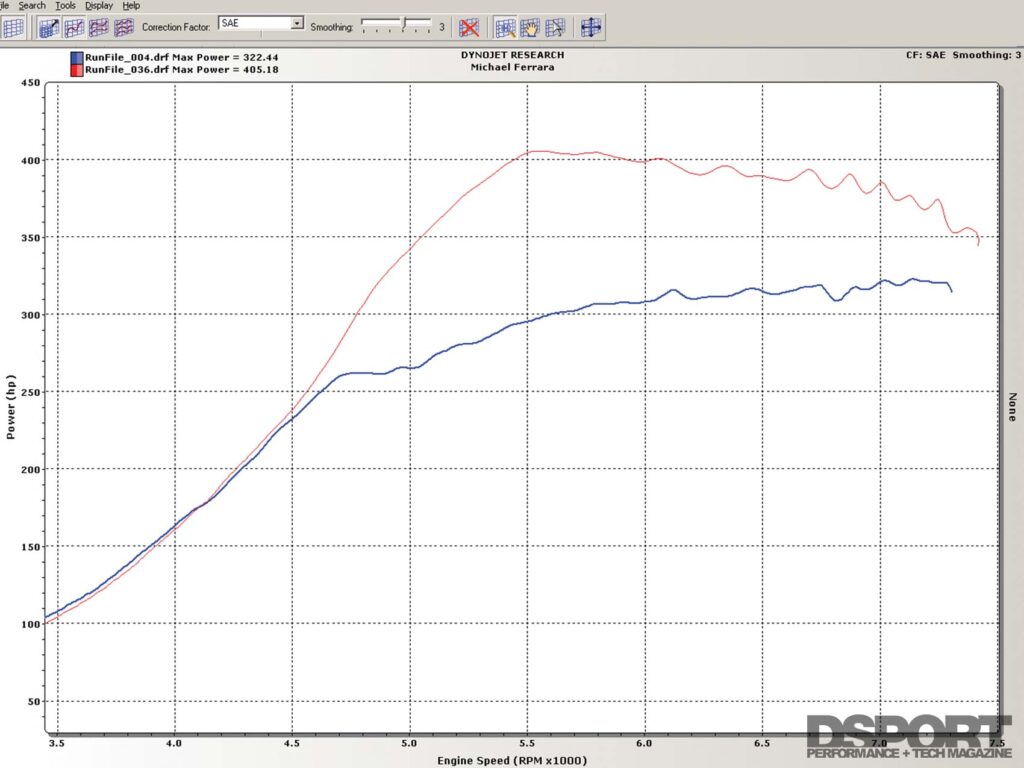What you feed your engine determines its ultimate performance. The nutritional performance needs of an engine are influenced by a number of factors. Some of these most important factors include an engine’s compression ratio, rpm potential and the boost pressure of the forced-induction system. Engines that run higher compression ratios (above 10:1), operate at higher speeds (generally over 6,500 rpm) or use some form of forced induction are usually the applications where improving the quality of the fuel results in a significant increase in performance.
Text by Michael Ferrara
DSPORT Issue #214
Fuel Octane
Blame that yellow and black sticker at the gas pumps for much of the misunderstanding about gasoline. Octane ratings are important, but they are not the only aspect of a fuel to consider. Each blend of gasoline has several important properties that can affect performance. Octane rating is just one of the performance specifications. Octane is directly related to knock.
Octane & Knock
The octane rating indicates the likelihood of the fuel to experience “knock.” Knock, the onomatopoeia named after the condition, is also known as detonation or autoignition. Whatever you call it, the important thing to keep in mind is that knock is detrimental to performance and reliability. Therefore, it must to be avoided.
Knock occurs when the fuel-air mixture in the cylinder does not experience an ideal burn. An ideal burn allows the mixture to combust evenly, initiating from the spark plug until all of the air-fuel mixture occurs. In a laboratory environment, the ideal burn will occur at about 100ft/second in a vacuum. In the turbulence of an engine’s combustion chamber, good flame speeds may be up to 250ft/second. During detonation, or knock, the burn rate will see a violent 2,000ft/second explosion instead of a burn. Burn rates are crucial to how the pressure builds in the cylinder.
The burning of the air-fuel mixture results in a pressure increase. Ideally, pressure builds in the cylinder after top dead center and peaks somewhere between 17 to 20 degrees. This allows the cylinder pressure to produce the most horsepower at the crank. When knock occurs, the pressure cycle within the cylinder doesn’t occur as desired. In fact, when knock occurs, the original flame front and pressure wave from the desired spark-ignited front meet a pressure wave from an undesired auto-ignited flame front. When these two pressure waves meet, the pressure oscillations produce a “knocking” sound. When knock occurs, power is reduced. Rod bearings, connecting rods, head gaskets and pistons may suffer slight damage or catastrophic failure depending on the severity of knock. Elevated temperatures generally result from knock and this can lead to preignition problems that cause the air-fuel mixture to ignite even before the spark fires.
Knock or detonation is not the same as preignition. Pre-ignition occurs when the air-fuel mixture becomes ignited before the spark plug fires. Sometimes temperatures that are higher than normal, or a hot spot in the cylinder, can lead to preignition. While both knock and preignition cause undesired burns of the air-fuel mixture, the difference between the two is simple. Knock or detonation occurs after the air-fuel mixture has started its burn, preignition occurs before. Both produce undesirable pressure waves that affect performance and can result in engine damage.
Avoid the Knock
 The sticker at the pump (or the octane rating provided by the race fuel manufacturer) expresses the “antiknock index” or (R+M/2) octane rating of the specific fuel. Fuel is generally tested by both a “Research Octane (ASTM D2699-92 [105]” and a ‘Motor Octane (ASTM D2700-92 [104]” method. The “R+M/2” number provided at the gas pump is the average of the values obtained by both methods. Both testing methods use a Cooperative Fuels Research engine that allows the operator to vary the compression ratio of the engine (from 4:1 to 18:1) and monitor for the presence of knock. The Research Method tests for knock at 600 RPM with the ignition timing fixed at 13 degrees Before Top Dead Center (BTDC). The Motor Octane method tests at 900 RPM but varies the ignition timing based on the compression ratio being tested. In general, Motor octane ratings will be lower than research numbers since the testing is more indicative of a more severe, high speed, high load condition.
The sticker at the pump (or the octane rating provided by the race fuel manufacturer) expresses the “antiknock index” or (R+M/2) octane rating of the specific fuel. Fuel is generally tested by both a “Research Octane (ASTM D2699-92 [105]” and a ‘Motor Octane (ASTM D2700-92 [104]” method. The “R+M/2” number provided at the gas pump is the average of the values obtained by both methods. Both testing methods use a Cooperative Fuels Research engine that allows the operator to vary the compression ratio of the engine (from 4:1 to 18:1) and monitor for the presence of knock. The Research Method tests for knock at 600 RPM with the ignition timing fixed at 13 degrees Before Top Dead Center (BTDC). The Motor Octane method tests at 900 RPM but varies the ignition timing based on the compression ratio being tested. In general, Motor octane ratings will be lower than research numbers since the testing is more indicative of a more severe, high speed, high load condition.
This number is important but it is just the tip of the iceberg. Bigger turbos, ported cylinder heads, performance camshafts, free-flowing exhaust systems and air intake systems offer effective methods of getting more air into the engine. However, it is always the engine’s ability to turn the fuel into energy that allows horsepower to be produced at the flywheel.
Need for Higher Octane
If your engine is experiencing knock, you need to run a higher-octane fuel. The need for fuels with a higher octane rating generally occurs as peak cylinder pressures rise. Peak cylinder pressures tend to rise as compression ratio, volumetric efficiency, ignition advance and boost pressure rise.
The general rules are simple. Naturally-aspirated engines will need a higher-octane fuel if either compression ratio is increased or ignition timing is advanced. Forced-induction engines respond the same as naturally-aspirated engines, but octane requirements will increase as boost pressures rise.
Too Much Octane
You may have heard the following: “don’t use too high of an octane fuel or you will lose power.” This is a half-truth. Having a fuel with too high of an octane will not cause your engine to lose power. The problem is that the popular components used to make the octane of a fuel higher slows the burn rate and a fuel with a burn rate that is too slow can result in an engine power loss. Of course, that is just typically what happens and it does not hold true for all fuels. In part 2, we will explore all of the alternative fuels, how they affect your engine’s performance and reliability, and which fuel is right for you.
Energy, Burn Rate and Vaporization
Let’s say we have a fuel that keeps our tune-up from experiencing knock. From this point, we would want to find a fuel that packs the most energy, has a compatible burn rate and has a vaporization characteristic that allows for peak performance.
Racing fuels are essentially blends of anywhere from three to 50 components. According to Steve Burns of VP Racing Fuels, “putting together a racing fuel is like putting together a salad. There are different types of lettuce, olives, tomatoes and dressings. A great salad is one that complements the engine combination being used.”
Your local gas station only offers E10 gasoline in three-different octane levels. It’s basically the same exact dish in three different levels of spicy. With racing gasoline, there isn’t just options in terms of octane level, there are other options in terms of other performance characteristics like burn rates and cooling factors. Hence, not all 100-octane racing gas formulations are going to deliver like performance. They will simply have similar resistance to knock (as they share the same octane rating).
Some fuel components add energy value to the fuel, some components are good burn accelerators and some components help vaporization. In general, energy values of different racing fuels are usually within three-to-five percent of each other. The burn rate and vaporization characteristics vary from fuel to fuel. Burn rates need to be fast enough so that all of the air-fuel mixture can combust in the cylinder. If the burn rate of the fuel is too slow, energy will be lost through the exhaust valve. As engine rpm increases, the amount of time that is available for the burn to take place is reduced. In that sense, a fuel that works well in an engine that revs to 6000 RPM, may not be the best fuel in an engine that revs to 10,000 RPM.
As for vaporization, here is the ideal scenario: The fuel would enter the combustion chamber as a liquid. The reason you would want it in liquid form is that this would not displace any of the air that could potentially make its way into the cylinder. However, when the intake valve closes and the compression stroke gets under way, all of the fuel should change from a liquid to vapor state. With the fuel in a vapor state mixed with the air in the cylinder, the air-fuel mixture can be ignited and a high percentage of the charge will go from reactants to products.
Alternative Fuels: Ethanol & Methanol
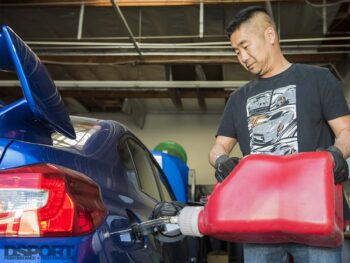 Ethanol-blended fuels such as E65, E85 and E98 have become popular due to the availability at the pump in many regions of the country. E65 is usually found during the winter months in colder climates while E85 is the standard for the rest of the year. E98 is usually only available by special order. The low-cost of E85 has made it a favorite among street enthusiasts living in areas that offer E85 at the pumps. In many cases, the power and performance levels reached on E85 are on par with high-performance, leaded racing gasoline. However, there are considerations when using E85. Engines running on E85 are a bit cold-blooded and may have trouble starting at lower outside temps. The entire fuel system must be compatible with E85 and the range available from a tank full of fuel will be reduced by about 40-percent. The advantage of ethanol is that it does not have the corrosive issues that you find with methanol but it does have a lower energy content than methanol. Methanol has been used as an alternative racing fuel to race gas for a number of years. One advantage of methanol is that it can be run very rich without a significant drop in power. This can allow the tuner to use the fuel as a cooling tool in the tuneup. The down side is that methanol can only pack about half of the energy found in gasoline. Fortunately, you can burn about twice the mass of methanol compared to gasoline with the same amount of air. Depending on the vehicle, anything from zero to ten percent more power can be made with methanol over racing gasoline. Do not let this power gain fool you. There are significant drawbacks for the power gains. First, methanol is highly corrosive. The entire fuel system must be methanol-compatible and even then corrosion still cannot completely be avoided. It is best to flush the system of methanol at the completion of the race. Another problem is that methanol requires twice the fuel delivery and storage capacity of gasoline. The fuel cell or gas tank will either need to double in size or you’ll only be able to travel half as far. Injectors and fuel pumps will need to have twice the flow capacity of a gasoline setup.
Ethanol-blended fuels such as E65, E85 and E98 have become popular due to the availability at the pump in many regions of the country. E65 is usually found during the winter months in colder climates while E85 is the standard for the rest of the year. E98 is usually only available by special order. The low-cost of E85 has made it a favorite among street enthusiasts living in areas that offer E85 at the pumps. In many cases, the power and performance levels reached on E85 are on par with high-performance, leaded racing gasoline. However, there are considerations when using E85. Engines running on E85 are a bit cold-blooded and may have trouble starting at lower outside temps. The entire fuel system must be compatible with E85 and the range available from a tank full of fuel will be reduced by about 40-percent. The advantage of ethanol is that it does not have the corrosive issues that you find with methanol but it does have a lower energy content than methanol. Methanol has been used as an alternative racing fuel to race gas for a number of years. One advantage of methanol is that it can be run very rich without a significant drop in power. This can allow the tuner to use the fuel as a cooling tool in the tuneup. The down side is that methanol can only pack about half of the energy found in gasoline. Fortunately, you can burn about twice the mass of methanol compared to gasoline with the same amount of air. Depending on the vehicle, anything from zero to ten percent more power can be made with methanol over racing gasoline. Do not let this power gain fool you. There are significant drawbacks for the power gains. First, methanol is highly corrosive. The entire fuel system must be methanol-compatible and even then corrosion still cannot completely be avoided. It is best to flush the system of methanol at the completion of the race. Another problem is that methanol requires twice the fuel delivery and storage capacity of gasoline. The fuel cell or gas tank will either need to double in size or you’ll only be able to travel half as far. Injectors and fuel pumps will need to have twice the flow capacity of a gasoline setup.
Add 100+ Horsepower for less than $100
We decided to see how three different race-gas blends (VP Racing Import, C16 and Q16) would affect the performance and tuning on our Project S15. On a diet of 91-octane pump gas, the SR20DET engine consistently produces over 320 horsepower to the wheels. With the entrée switched out to some of VP Racing’s top racing gas blends, the same engine made over 90 more peak horsepower at the wheels. Understanding the science of race fuels will help you pick the best blend for your vehicle. Choosing the right fuel and tuning to optimize this fuel will allow your engine to develop more power at a higher degree of reliability than ever before.
The Dyno Says…
The dyno showed a peak horsepower output of 322 horsepower with 91-octane pump gas and the boost set to 1.1 bar. With the engine running on VP Import, the tuner was able to adjust the fuel and ignition tables to realize a significant power increase at the same boost level. The peak power output jumped to 370 horsepower, a gain of 48 horsepower. Significant gains in the power output started at 4,500 RPM and continued to redline. After 13 full-throttle passes on the dyno, the tuning was optimized for the VP Import gas at the higher 1.6 bar boost level. Now, peak power checked in at 413 horsepower; a gain of 91 horsepower at the wheels, or roughly 107 horsepower at the flywheel. At 5,700 RPM, the maximum gain of over 112 horsepower at the wheels was realized (132 hp at the flywheel).
While a racing gasoline may only deliver a 10-percent performance gain on an “all-motor” engine, a boosted engine is a completely different story. Turbocharged and supercharged engines can often run increased boost levels with fuels less likely to encounter knock. Cranking up the boost often leads to major gains in torque and horsepower output. Same engine, better fuel and higher boost shown above.
Next up, it was time to test VP Racing’s new Q16 blend. As we mentioned before Q16 was formulated to offer performance very close to VP Import at nearly half the price. After eight full-throttle passes to get the A/F ratios matched and the power output maximized, the results were in. Q16 resulted in an output of 412 peak horsepower with a power curve that mimicked the curve for VP Import. For VP Racing Fuels, Q16 seems to have hit its mark.
The last race fuel to test was the venerable C16. With the C16, peak power hit a maximum of just 405 horsepower (7 to 8 peak horsepower less than VP Import and Q16). While that may not seem like a significant difference, peak power differences do not tell the whole story. Past 6,500 RPM, the power output from C16 was considerably less than Q16 or VP Import due to C16’s slower burn rate. At 7,000 RPM to redline, the difference in output was 20-to-30 horsepower less than VP Import or Q16. Thus, if your engine spends time above 6,500 RPM, Q16 or VP Import is going to give your engine significant power gains.
Tuning Notes
The tuning for each fuel was significantly different. The standard used was to keep the A/F ratio between 11.3 and 11.5-to-1. The timing was optimized to provide the minimum ignition advance needed to realize the optimum torque. With the VP Import blend, additional ignition advance beyond the minimum needed for best torque was possible. Hence, you could advance the timing more with the VP Import blend without encountering knock (which would occur at those same ignition timing settings with C16 and Q16). However, this was more of a safety or reliability advantage as the additional timing advance allowed by VP Import didn’t translate into the engine making measurably more power over the Q16 blend.


